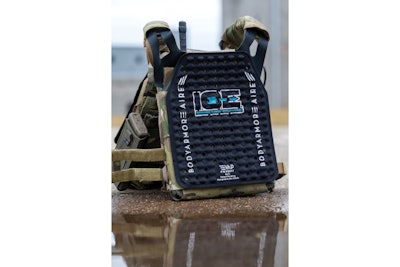 The I.C.E. panel from Body Armor Vent attaches to the officer's armor carrier and is worn between the base layer and the carrier.
The I.C.E. panel from Body Armor Vent attaches to the officer's armor carrier and is worn between the base layer and the carrier.
The president and CEO of Body Armor Vent John Murphy says his company has a mission to make officers more comfortable on duty. "Every cop who wears body armor knows how miserable it can be in hot humid weather," he says. "You can change your T-shirt five times a day and you are still soaking wet."
The idea behind the signature product of Body Armor Vent, the I.C.E. (Increased Combat Effectiveness) panel is to allow air to flow between the armor wearer's carrier and his or her T-shirt. Its EVAP Technology lets the sweat dry, which provide natural cooling.
When Murphy first became involved with Body Armor Vent, he didn't know what it was like to be a law enforcement officer and work all day in body armor. He was a semi-retired textile expert who had sold a company that specialized in providing high-tech fabrics and was working as a business consultant just for fun.
A medically retired police officer had the original idea for Body Armor Vent and approached Murphy about the concept. What he needed from Murphy was the expertise in textiles and the business experience to create and market the product. They formed a partnership and Murphy helped him create prototypes. Murphy now owns the company.
The first design of the product was actually inflated. It was an innovative lightweight panel with air channels. The user pumped air into the panel through a valve using a small detachable bulb. After about 10 days the panel would lose inflation and need to be pumped up again. That version worked just fine to cool off the wearer, but some of the potential customers, especially military customers, were not thrilled with the detachable bulb. "My troops would lose that bulb in a week," a high-ranking military officer told Murphy.
From his decades in the textile industry, Murphy had plenty of contacts with the kind of sophisticated capabilities and machinery needed to rework the I.C.E. panel design. So he wasn't discouraged by the military's rejection. He went to his contacts and asked, "Can we replace the air in the channels with something that is featherweight but requires no inflation?" The solution was a proprietary sealed foam system.
The new version of the I.C.E. panel is lighter and better sculpted, so it can keep the wearer cooler, Murphy says. The design of the panel produces a "chimney effect," moving the hot, wet air up and away from the wearer's body, he adds. Body Armor Vent has used thermographic photography to show that its I.C.E. panel keeps the wearer 17 degrees cooler than they would be with a carrier and a T-shirt and no I.C.E. panel. "The I.C.E. panel really changes life for law enforcement officers," Murphy says.
Debuting at last year's SHOT Show, the new I.C.E. panels are available as an accessory in Point Blank's Elite kit and are sold separately by Body Armor Vent and a number of police supply companies.
Buyers receive two panels, front and back. Inside the package there is instructions for how to install the panels and hook-and-loop tape with a strong adhesive for mounting the panels to a carrier. The company recommends that buyers wash their carriers well and let dry completely before applying the tape.
I.C.E. panels are available in four sizes from extra small to large. Murphy says the sizes correspond to the wearer's T-shirt size. If there is a sizing issue, buyers can return the product. MSRP is $68.50. Group rates can be negotiated. The product is covered by a lifetime warranty.

















